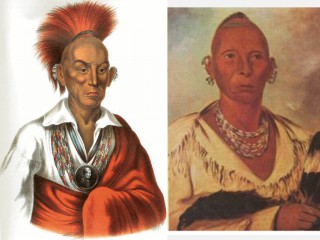
Black Hawk biography
Date of birth : -
Date of death : -
Birthplace : Rock River, U.S.
Nationality : Native American
Category : Historian personalities
Last modified : 2011-01-20
Credited as : War chief, Sauk leader,
A Native American war chief, Black Hawk (1767-1838) led his people, the Sauk, in a noble fight to preserve their tribal lands in Illinois, Wisconsin, and Missouri.
At the great Sauk village on the Rock River (near the present city of Rock Island, Ill.), Black Hawk was born and given the name Ma-ka-tai-me-she-kiakiak (Black Sparrow Hawk). His tribe had a long tradition of trading furs to Spaniards and Frenchmen in St. Louis for supplies and weapons. It was there Black Hawk first heard of Americans, and he took a strong dislike to them when he learned they had made the Louisiana Purchase.
In 1804 William Henry Harrison negotiated a treaty with another Sauk chief, named Quashquame, and a Fox chief; in the treaty the Sauk and Fox tribes agreed to cede 15 million acres of their land to the United States; this cession included the Sauk lands in Illinois—and thus the site of their great village on the Rock River. Black Hawk, by now a rising war chief, always claimed that Quashquame and the other chief had made this treaty with no tribal authority and had in fact been induced to sign it while drunk.
During the War of 1812, because of his hatred of the United States, Black Hawk sided with the British and fought under Tecumseh, a charismatic leader preaching Native American unity against the Americans. In 1816 Black Hawk signed a document confirming the treaty of 1804, but afterward he claimed he was ignorant of the terms of the agreement. Between 1816 and 1829 he brooded about the loss of the Sauk and Fox lands east of the Mississippi River and worked to get British help from Canada for an Indian uprising. Also, in league with White Cloud, a Waubesheik medicine man and prophet, he sought a general Native American confederation against the United States.
In June 1831, under Black Hawk's leadership, the Sauk returned to their ancient village on the Rock River. However, American troops soon arrived at Rock Island at the request of the governor of Illinois. Black Hawk thereupon withdrew to the mouth of the lowa River on the west side of the Mississippi.
A year later, in April, Black Hawk and 400 to 500 warriors and their families recrossed the Mississippi to fight for their lands in Illinois, Wisconsin, and Missouri. They believed they would receive help from Canada, and some Winnebago, Potawatomi, and Mascouten did join them. Before they could reach the site of their old village, however, American troops arrived, whereupon Black Hawk's army disintegrated.
The conflict known as the Black Hawk War began when Illinois volunteers assaulted those sent by the Sauk chief under a flag of truce to parley. Two Indians were killed in the fighting. Black Hawk led his warriors northward, pursued by troops and Illinois volunteers, which included young Abraham Lincoln. Hampered by hunger and by their women and children, the Sauk retreated west of the Mississippi to end the fighting. But they were attacked at the mouth of Bad Axe River in Wisconsin, were defeated, and surrendered. Black Hawk, two of his sons, and other chiefs, including White Cloud, were taken as prisoners to Fort Armstrong, commanded by Gen. Winfield Scott. There on Sept. 21, 1832, a new treaty was signed, called the Black Hawk Purchase, in which the Sauk gave up more of their land in return for an annuity and a reservation in lowa.
In the spring of 1833 Black Hawk was taken east for a meeting with President Andrew Jackson. Afterward, he was confined for a short time at Fortress Monroe, Va., before being returned to lowa. But Black Hawk's position as tribal leader had been undermined by younger men who did not want to fight the whites, and he spent his last days in lowa, under the supervision of Chief Keokuk. He dictated his reminiscences to a journalist, J. B. Patterson, explaining his position and his attitudes before he died on Oct. 3, 1838, at his lodge on the Des Moines River.
The Autobiography of Black Hawk, edited by J. B. Patterson (1833), was republished in 1955 as Black Hawk: An Autobiography, edited by Donald Jackson. Other useful works include Frank E. Stevens, The Black Hawk War: Including a Review of Black Hawk's Life (1903), and William T. Hagan, The Sac and Fox Indians (1958).
















